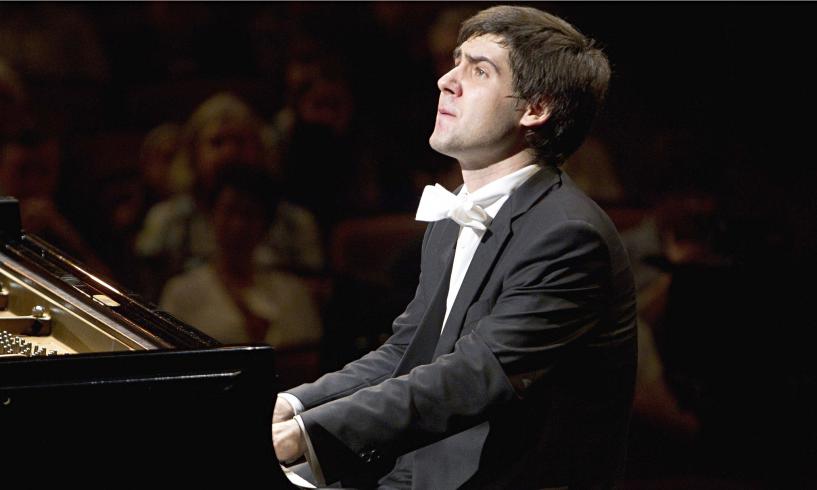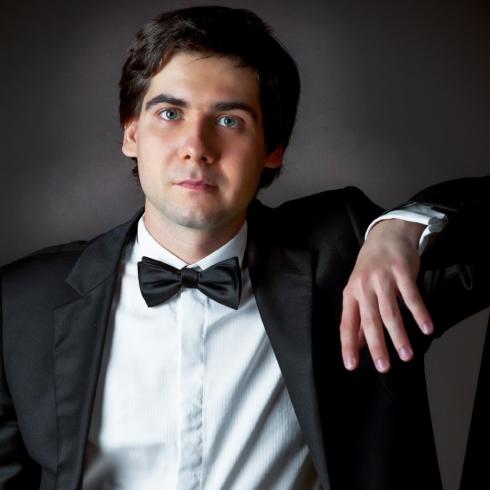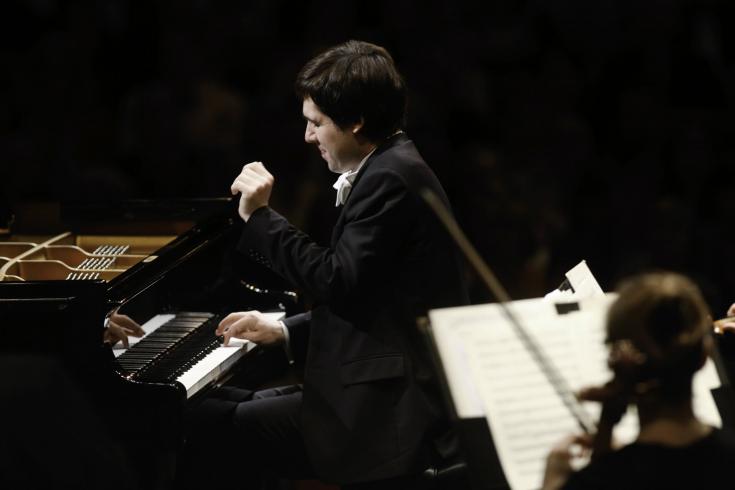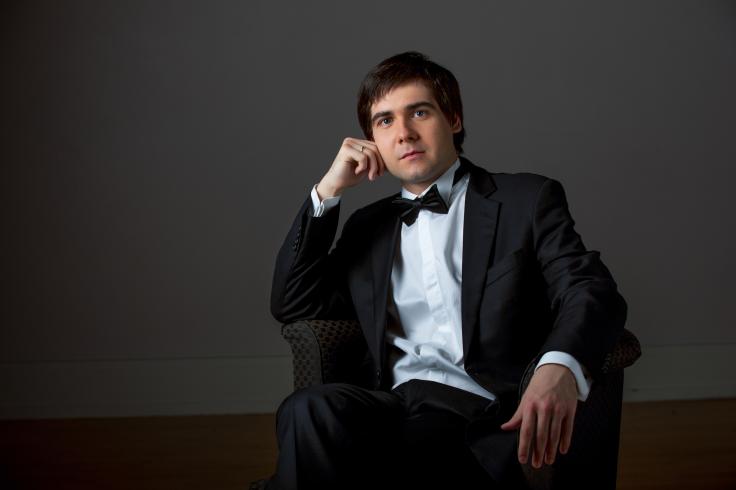Vadym Kholodenko
Piano
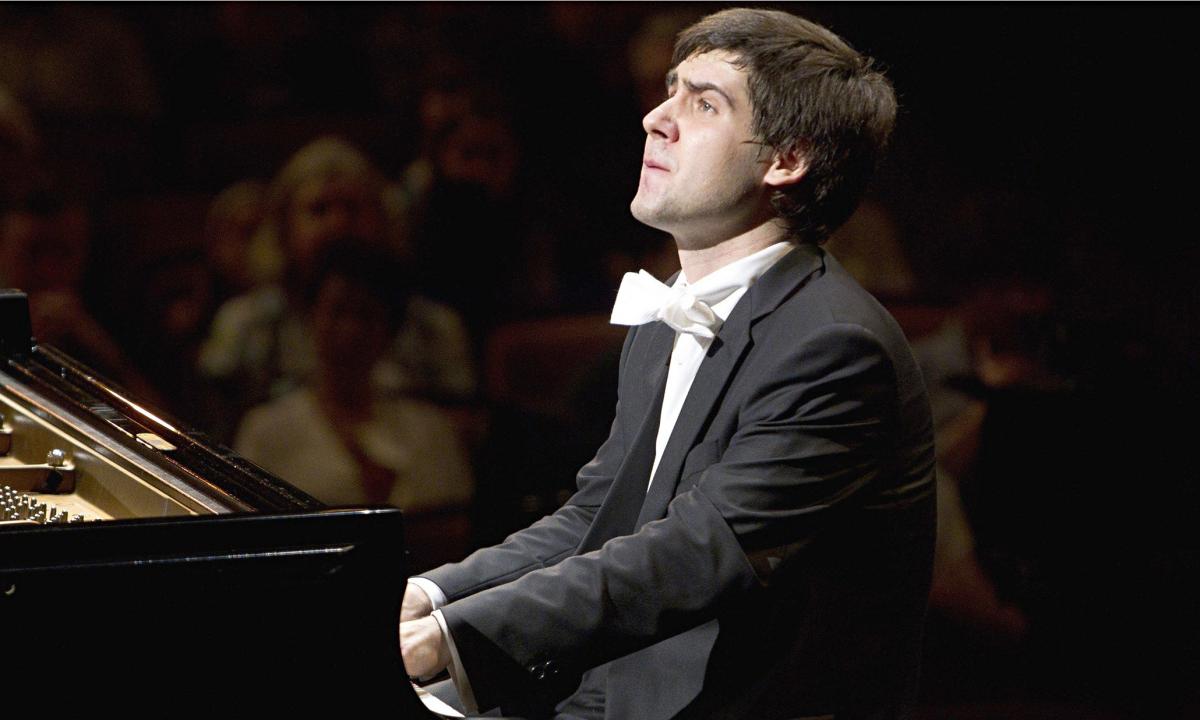
Ukrainian pianist Vadym Kholodenko makes his DC debut with selections by Ravel, Schumann, and Rachmaninoff.
Program
Born in Ukraine and following studies in Russia, Vadym Kholodenko first came to international prominence when he won the Van Cliburn Piano Competition in 2013. Since then his combination of spectacular technique and intelligent musicianship has attracted praise all over the world, not only in solo repertoire but also in chamber music. In this concert, Kholodenko frames music by Schumann—notably Kreisleriana, dedicated to Chopin and described by Schumann himself as his “favorite piece”—with the delectable restraint of Ravel’s Sonatine and Tombeau de Couperin along with two of Rachmaninoff’s mighty Études-tableaux.
PROGRAM:
MAURICE RAVEL (1875-1937)
Sonatine
Modéré
Mouvement de menuet
Animé
Tombeau de Couperin
Prélude. Vif
Fugue. Allegro moderato
Forlane. Allegretto
Rigaudon. Assez vif
Menuet. Allegro moderato
Toccata. Vif
Intermission
ROBERT SCHUMANN (1810-1856)
4 Klavierstucke Op. 32
Scherzo
Gigue
Romanze
Fughette
Kreisleriana Op. 16
Äußerst bewegt
Sehr inning und nicht zu rasch
Sehr aufgeregt
Sehr langsam
Sehr lebhaft
Sehr langsam
Sehr rasch
Schnell und spielend
SERGEI RACHMANINOV (1873-1943)
Etudes-tableaux Op. 39
No. 7 Lento lugubre in C minor
No. 9 Allegro moderato. Tempo di marcia in D Major
About the Artist
Vadym Kholodenko has emerged as one of the most musically dynamic and technically gifted performers of his generation, heralded for interpretations that are “impeccable, tasteful and vibrant, and also something more: imaginative” (Cleveland Plain Dealer). Winner of the coveted gold medal and all special prizes at the Fourteenth Van Cliburn International Piano Competition in 2013, he is forging an international career throughout Europe, Asia, and North America to great acclaim.
In the 2015–2016 season, Kholodenko makes debuts with the Atlanta, Eugene, and Hawaii Symphony Orchestras, and also with the Royal Philharmonic Orchestra in a special concert presented by the San Diego Symphony. He enters the second year of his artistic partnership with the Fort Worth Symphony Orchestra with the continuation of the Prokofiev piano concerto cycle and chamber projects, and returns to the Rochester Philharmonic. European engagements include debuts with the BBC Scottish, Kristiansand Symphony, Spanish National, and Sydney Symphony Orchestras, and a return to the Norwegian Radio Orchestra. In August 2015, he appeared in Zurich with the Moscow Tchaikovsky Symphony Orchestra conducted by Vladimir Fedoseyev under the auspices of the Orpheum Foundation for the Advancement of Young Soloists. Recitals will take him to Austin, Budapest, Porto, Vancouver, and other cities around the world.
In recent seasons, Kholodenko has appeared with the orchestras of Fort Worth, Indianapolis, Pacific, Philadelphia, Phoenix, Omaha, Rochester, San Diego, Malmö, Madrid RTVE, Qatar, Norwegian Radio, and Orquestra Sinfónica do Porto Casa da Música, working with Leonard Slatkin, Miguel Harth-Bedoya, Yuri Bashmet, Carl St. Clair, Christopher Seaman, Vladimir Spivakov, and other distinguished conductors. He has traveled extensively across the United States for solo recitals, including Boston, Houston, Indianapolis, La Jolla, Los Angeles, Miami, Portland, and Seattle. Internationally, he has made recital debuts in Paris, Rio de Janeiro, Sarajevo, Singapore, and throughout Germany, Italy, Switzerland, the United Kingdom, and Japan. Performing frequently in Russia, Kholodenko also held a residency at the Mariinsky Concert Hall, where he was named Artist of the Month by Valery Gergiev. Festival appearances include the Aspen Summer Music, Brevard Music Center, Flâneries Musicales de Reims, Pharos Chamber Music, Stars of the White Nights, and Festival del Sole.
A committed chamber musician, Kholodenko took home the 2013 Cliburn prize for best performance of a piano quintet with the Brentano Quartet. He has also collaborated with the Enso Quartet, violinists Vadim Repin and Alena Baeva, and cellist Nina Kotova, and formed the piano duet iDuo with Andrey Gugnin. Also interested in composing, he performed a stunning cadenza in Mozart’s Concerto No. 21 in C Major, K. 467 during the Cliburn Competition’s Final Round—which he composed himself on the plane from Moscow to the Competition. He also often programs his own transcriptions as encores or in concerts.
Kholodenko’s first recording for harmonia mundi was released in November 2013, featuring Stravinsky’s Trois mouvements de Petrouchka and the complete Liszt Transcendental Etudes, which Audiophile Audition deemed “pure gold.”
Born in Kiev, Vadym Kholodenko is the first musician in his family. He began his studies at Kiev’s Mykola Lysenko Special Music School under Natalia Grydneva and Borys Fedorov. He made his first appearances in the United States, China, Hungary, and Croatia at the age of 13. In 2005, he moved to Moscow to study at the Moscow State Conservatoire with Vera Gornostaeva. Under her tutelage, he won top prizes at the 2011 Schubert, 2010 Sendai, and 2010 Maria Callas International Piano Competitions.
Notes
Notes by Nigel Simeone
MAURICE RAVEL (1875-1937)
Sonatine
Ravel composed his Sonatine in 1903–1905, just after finishing the String Quartet and the song-cycle Schéhérazade. After several fruitless attempts to win the coveted Prix de Rome for compositions, Ravel finally decided that he should pursue his own musical path, and the Sonatine was one of the first results – a work of great refinement, and a much smaller scale than the piano cycle Miroirs the he worked on at the same time. Ravel’s title evokes something of the elegance of the Classical period, though from the very start it is obvious that Ravel is not attempting any kind of pastiche here. Even so, the first movement is in a clearly defined sonata form. The opening presents a singing theme in octaves with a shimmering accompaniment in the inner parts. The second theme is gentler, supported by some typically luminous harmonies. The central Minuet is a graceful and stylish dance, and this is followed by the quick finale, driven and energized by the almost ever-present rapid notes introduced at the start of the movement. There are moments of repose, but the essential vitality of this movement comes surging back for flamboyant conclusion. Ravel dedicated the Sonatine to Ida and Cipa Godebski, two of his closest friends. The premiere was given in Lyon on March 10, 1906 by Mme Paule de Lestaing, and it was first performed in Paris on March 31, 1906, by the pianist and composer Gabriel Grovlez.
Le Tombeau de Couperin
Le Tombeau de Couperin is a double memorial. As the title suggests, it is a homage to the clavecinistes, the great harpsichord composers of the French Baroque, above all François Couperin ‘le grand’ (1668–1733) whose music Ravel knew well, and one of whose pieces (a ‘Forlane’ from one of Couperin’s Concerts royaux) he transcribed for piano shortly before starting work on Le Tombeau de Couperin. The forms used by Ravel are familiar from Baroque harpsichord suites, though, as always, Ravel reinvents them to suit his own purposes. Much of the work was conceived in 1914, just before the outbreak of World War I, but by the time he finished the cycle, it had become a poignant memorial to six of his friends killed in the war. The first edition of the score has a title page drawn by Ravel himself depicting a funeral urn. The Prélude is dedicated to the memory of Jacques Charlot, a cousin of Ravel’s publisher Jacques Durand who was killed in battle in March 1915 at the age of thirty (Debussy also dedicated one the movements of En blanc et noir to Charlot). The busy but clean-lined keyboard textures are clearly indebted to harpsichord writing, but Ravel’s harmonies are unmistakably his own. The Fugue demonstrates Ravel’s contrapuntal ingenuity, weaving a fugal texture of great individuality and considerable technical skill. It was dedicated to Jean Cruppi, son of the Mme Cruppi to whom Ravel had earlier dedicated his opera L’Heure espagnole. The Forlane has a rhythm and texture closely related to Couperin’s original, but Ravel’s more adventurous harmonies place it firmly in the twentieth century. The dedicatee is the painter Gabriel Deluc, a Basque artist one of whose pictures Ravel owned (it depicts two dancing figures from antiquity, strongly reminiscent of Ravel’s Daphnis et Chloé). He fell at Souhain on September 15, 1916. The Rigaudon is one of the most exuberant pieces in the set, a brilliant dance movement that Ravel inscribed to the memory of Pierre and Pascal Gaudin who were friends of Ravel from his home town of Saint-Jean-de-Luz. The Menuet is marked by tender modal harmonies, and a haunting central section (over which Ravel took an enormous amount of trouble, as can be seen in his sketches for the work). After Ravel’s own service at the front between March and October 1916, he recuperated at the home of Mme Fernand Dreyfus. Her stepson, Jean Dreyfus, was killed in late 1916 or early 1917, and the Menuet is inscribed to his memory. The final Toccata is filled with constant movement and brilliant colors that animate the piano texture. It is dedicated to Joseph de Marliave (killed in the first weeks of the war). He was a friend of Fauré, author of a book on Beethoven’s string quartets, and the husband of the pianist Marguerite Long – who went on to give the first performance of Le Tombeau de Couperin at the Salle Gaveau in Paris on April 11, 1919.
ROBERT SCHUMANN (1810-1856)
4 Klavierstücke Op. 32
Like Ravel, Schumann was interested in music from earlier periods, and these short pieces reflect his enthusiasm for Bach and Mozart in their lighter vein. The four pieces published as Schumann’s Op. 32 were composed over a period of a few years, between 1839 and 1841. They are not among his better-known piano works and one reason for their relative neglect might well be the unwieldy title under which they were first published as a set. Despite the pleas of Schumann’s publisher to call them “Pièces romantiques,” Schumann insisted on Scherzo, Gigue, Romanze and Fughette. The first two to be composed (the Gigue and Fuguette) appeared as musical supplements in the Neue Zeitschrift für Musik, the musical journal edited by Schumann himself. The first to appear was the Gigue, a dance form about which the composer was distinctly uncertain. Writing to Clara Wieck in 1839, he admitted that “I don’t exactly know what a gigue is: it is an old and forgotten dance in triple time with fugal entrances. Do you like it?” The Fuguette appeared as a supplement in June 1840. The Scherzo and Romanze were first published with the other two pieces in the set, in March 1841, by which time Schumann was married to Clara (their wedding was on 12 September 1840). However, the dedication was not to her, but to Amalie Rieffel, a brilliant young pianist of whom Clara was extremely wary. Writing in her diary the same month as her marriage to Robert, she wrote: “I have a dangerous rival in the Rieffel woman. Robert prefers her renditions of his works to mine. He says she plays them with greater exactitude.” Clara need not have worried, but Schumann clearly thought highly of Amalie Rieffel, and these delightful pieces deserve to be more widely known.
Kreisleriana Op. 16
Writing to a Belgian friend in 1839, Schumann wrote that of all his recent piano pieces, “I love Kreisleriana the most,” though he went on to admit that “only Germans will be able to understand the title.” In the same letter, he explained this to his French-speaking friend: “Kreisler was created by E.T.A. Hoffmann, an eccentric, wild and ingenious musician. There are many things about him you will like.” Unusually for Schumann, he had the title of the work in mind before starting composition, with the intention all along of producing a musical portrait of Hoffmann’s fictitious character. The volatile mood of Kreisleriana and the almost improvised feeling of several of the pieces are extremely inventive musical parallels for Johannes Kreisler’s personality. By turns, passionate, intimate, capricious, dream-like, and dramatic in tone, Schumann wrote the pieces for Clara Wieck (whom he was to marry in 1840, despite her father’s objections). Schumann told her that in Kreisleriana “you, and an idea of you, will play the main role, and I wish to dedicate it to you. You will smile so sweetly when you recognize yourself in them.” Ultimately, the dedication was changed (apparently Clara was afraid that a dedication to her would risk worsening the strained relations with her father), and the first edition of the work – published by Haslinger in Vienna in 1838 – had an inscription from Schumann “to his friend F. Chopin.” Though Chopin’s reaction was apparently less than enthusiastic (all he felt able to praise was the attractive design of the title page), the following year he reciprocated by dedicating his Second Ballade to Schumann.
SERGEI RACHMANINOV (1873-1943)
Etudes-tableaux Op. 39
The second set of Études-tableaux, published as his Op. 39, were Rachmaninov’s musical farewell to Russia: composed in 1916–1917, he left the country for good after the October Revolution in 1917. The seventh of the Etudes is marked Lento lugubre and it is profoundly serious in mood, beginning in the manner of a funeral march before a quiet melody emerges over gentle pulsating chords, growing slowly and inexorably to a huge fortissimo climax before subsiding into the dark sound-world in which it had begun. This was one of the five Études-tableaux orchestrated by Respighi in 1930, and Rachmaninov told him that it was a description of a funeral: “The initial theme is a march. The other theme represents the singing of a choir. Commencing with the movement in 16th in C minor and a little further on in E-flat minor a fine rain is suggested, incessant and hopeless. The movement develops, culminating in C minor – the chimes of a church. The final section returns to the first theme.” It is certainly possible that Rachmaninov wrote this piece as a reaction to the death of Scriabin in 1915.
The ninth and last of the Etudes was another of those chosen by the composer himself to be orchestrated by Respighi, but Rachmaninov was much less expansive in his description of it, saying only that it resembles an oriental march. It is a stirring display piece, bringing the set to a magnificent and heroic conclusion.
Watch & Listen
Cliburn 2013 Vadym Kholodenko Preliminary Recital II from The Cliburn on Vimeo.
